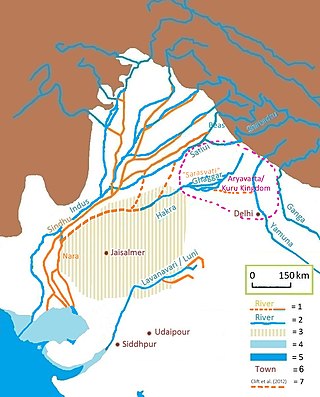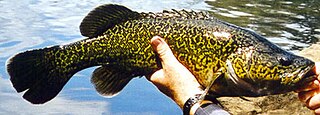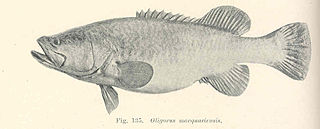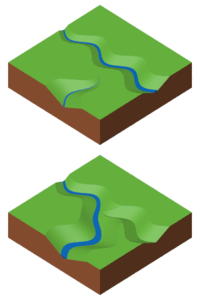
The Murray River is a river in Southeastern Australia. It is Australia's longest river at 2,508 km (1,558 mi) extent. Its tributaries include five of the next six longest rivers of Australia. Together with that of the Murray, the catchments of these rivers form the Murray–Darling basin, which covers about one-seventh the area of Australia. It is widely considered Australia's most important irrigated region.

The Sarasvati River is a mythologized and deified ancient river first mentioned in the Rigveda and later in Vedic and post-Vedic texts. It played an important role in the Vedic religion, appearing in all but the fourth book of the Rigveda.

The Darling River is the third-longest river in Australia, measuring 1,472 kilometres (915 mi) from its source in northern New South Wales to its confluence with the Murray River at Wentworth. Including its longest contiguous tributaries it is 2,844 km (1,767 mi) long, making it the longest river system in Australia. The Darling River is the outback's most famous waterway.

The Murray cod is a large Australian predatory freshwater fish of the genus Maccullochella in the family Percichthyidae. Although the species is called a cod in the vernacular, it is not related to the Northern Hemisphere marine cod (Gadus) species. The Murray cod is an important part of Australia's vertebrate wildlife—as an apex predator in the Murray-Darling River system—and also significant in Australia's human culture. The Murray cod is the largest exclusively freshwater fish in Australia, and one of the largest in the world. Other common names for Murray cod include cod, greenfish, goodoo, Mary River cod, Murray perch, ponde, pondi and Queensland freshwater cod.

The eastern freshwater cod, also known as the eastern cod or Clarence River cod, is a large predatory freshwater fish of the genus Maccullochella and the family Percichthyidae, that occur in the coastal Clarence River system of north-eastern New South Wales. Eastern freshwater cod are closely related to the Murray cod of the Murray-Darling River system, and are considered an icon of the Clarence River system.

The trout cod or bluenose cod, is a large predatory freshwater fish of the genus Maccullochella and the family Percichthyidae, closely related to the Murray cod. It was originally widespread in the south-east corner of the Murray-Darling river system in Australia, but is now an endangered species.

The Murray–Darling Basin is a large geographical area in the interior of southeastern Australia, encompassing the drainage basin of the tributaries of the Murray River, Australia's longest river, and the Darling River, a right tributary of the Murray and Australia's third-longest river. The Basin, which includes six of Australia's seven longest rivers and covers around one-seventh of the Australian landmass, is one of the country's most significant agricultural areas providing one-third of Australia's food supply. Located west of the Great Dividing Range, it drains southwest into the Great Australian Bight and spans most of the states of New South Wales and Victoria, the Australian Capital Territory, and parts of the states of Queensland and South Australia.

Barmah is a town in the state of Victoria, Australia.

The Macquarie perch is an Australian native freshwater fish of the Murray-Darling river system. It is a member of the family Percichthyidae and is closely related to the golden perch.

The golden perch is a medium-sized, yellow or gold-coloured species of Australian freshwater fish found primarily in the Murray-Darling River system, though a subspecies is found in the Lake Eyre-Cooper Creek system, and another subspecies, suspected to be ancestral to all other populations, is found in the Fitzroy River system in Queensland. Other common names for golden perch are "goldens", “yellowbelly” and "callop", the last generally used only in South Australia.

The river blackfish is a freshwater fish endemic to the temperate waters of south-eastern Australia. It is found from southern Queensland through to central Victoria, including in the Murray-Darling river system. It is also found in some eastern and southern flowing coastal rivers. Found primarily in upland and "midland" habitats, though early records of fish fauna suggest it was originally far more extensively distributed and was found in some lowland habitats as well. Originally, river blackfish co-inhabited many of its lowland and "midland" habitats with species such as Murray cod and golden perch, and its upland habitats with species such as trout cod and Macquarie perch. It is a popular angling fish in some parts of its range.

The common yabby is an Australian freshwater crustacean in the Parastacidae family. It is listed as a vulnerable species of crayfish by the International Union for Conservation of Nature (IUCN), though the wild yabby populations remain strong, and have expanded into new habitats created by reservoirs and farm dams.

The western carp gudgeon is one of several carp gudgeon species. Carp gudgeons are very small perciform fish found in the Australian Murray-Darling River system, mainly in lowland environments, but some have been observed in upland environments. They are often found in small creeks, as well as billabongs and the edges of larger rivers. They prefer water 1 to 2 m deep with aquatic weed and structure provided by rocks or sunken timber.

The eel-tailed catfish is a species of catfish of the family Plotosidae. This fish is also known as dewfish, freshwater catfish, jewfish, and tandan.
The Richmond River cod was a form of Maccullochella cod, now believed to have been eastern freshwater cod, Maccullochella ikei, that occurred naturally in the Richmond River system, an east coast river system in north-east New South Wales, Australia.
The Brisbane River cod was a unique form of Maccullochella cod that occurred naturally in the Brisbane River system, an east coast river system in south east Queensland, Australia. The Brisbane River Cod was known as the Bumgur by the Jinibara people centred in the Kilcoy region and the junction of the Stanley and Brisbane Rivers. Their exact taxonomic status is not known, but based on several genetic studies it is suspected that Brisbane River Cod were a species intermediate between eastern freshwater cod of the Clarence River and Richmond River systems in northern New South Wales and Mary River cod of the Mary River in southern Queensland.

The silver perch is a medium-sized freshwater fish of the family Terapontidae endemic to the Murray-Darling river system in south-eastern Australia.

Galaxias olidus, the mountain galaxias, is a species of freshwater galaxiid fish widely found in southeastern Australia.

The Australian smelt is a small, pelagic silvery freshwater fish found in large numbers in waters of the south eastern Australian mainland.

The Crookwell River is a perennial river that is part of the Lachlan catchment within the Murray–Darling basin, located in the Southern Tablelands and South West Slopes regions of New South Wales, Australia.



















